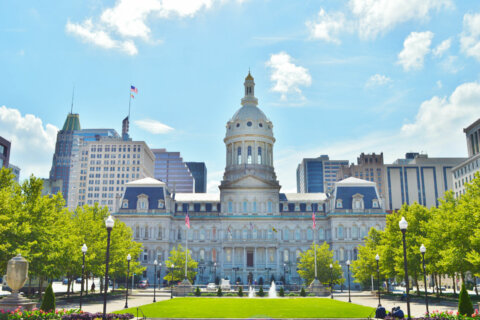A structural engineering professor at Johns Hopkins University in Baltimore joined WTOP Tuesday morning following the collapse of the Francis Scott Key Bridge after it was struck by a large container ship.
Ben Schafer talked with WTOP’s Michelle Basch and John Aaron to explain what happened and what lessons may be learned.
Listen to the interview below or read the transcript.
John Aaron: Joining us live now to dig deeper into what might have happened is Ben Schafer. He’s a structural engineering professor at Johns Hopkins University. Thank you for joining us, professor. We’ve seen the video, we see the ship hit the support pillars, obviously, that’s something very bad to happen. But what surprised me, and I guess a lot of other people, is this sort of domino effect of section after section of the bridge going down. Can you explain exactly what happened here?
Ben Schafer: So watching the video like everyone has, and looking at the first couple of seconds of it, it seems to be a case of bridge supported at two points, and you lose one of them. So the bridge falls directly down. When the ship strikes — and nothing really changes in the superstructure in the first few seconds, it’s just moving vertically down because it’s lost its support — then it can’t accommodate that movement any further and then you start to see pieces of the bridge collapse and dominoes over — that 30 seconds of that video. Had it been a shorter span bridge, the whole thing would have happened the same way, but just much faster. Can’t support something on just two legs and expect to lose one.
Michelle Basch: We know this bridge went up in the 1970s. Do you think age has anything to do with how it went down?
Ben Schafer: I have no indication of that. It’s a sound bridge design and had been used in other locations. And service was — there’s no indications of problems with it over time. With any bridge, there’s maintenance issues. Fifty years into its design life and with its foundation, I don’t think there’s many bridges that are going to survive container ship head on to one of its major supports directly as we saw this morning.
John Aaron: Yeah, I was going ask you, bridges designed with the fact that they might get bumped into in mind. Granted, this was a gigantic ship. But I guess that answers the question.
Ben Schafer: Yeah, I mean, I guess there’s two aspects of that. One is container ships have changed a lot since the 1970s. They’re bigger and bigger and bigger. When you see the images now, the container ship is as wide as the bridge was tall. The scales are almost similar. It isn’t a little boat, a little boat that’s just sort of drifting by and needs to be guided away. I don’t know the details of the protection system directly at the bridge or how they use or don’t use tugboats to manage coming in to the port. Certainly, I do think if we’re going to have lessons learned, it’s going to be around that kind of port maintenance and the way we handle getting the ships in and out when it’s going through critical infrastructure like this.
Michelle Basch: Should we be worried about more aging infrastructure across our country?
Ben Schafer: Worried is a difficult word. There is a number of experts that work hard and to communicate to everybody about what … to do with our infrastructure. Needless to say, the American Society of Civil Engineers and the various state highway associations have indicated many times that they need additional funding to try to keep the infrastructure in better shape. So I think everyone’s doing the best with what they can. Infrastructure investment, as we’ve had a little bit now in this current administration is helpful, but there’s still a lot of work to be done for an infrastructure that was largely built 50 plus years ago for the country.
Get breaking news and daily headlines delivered to your email inbox by signing up here.
© 2024 WTOP. All Rights Reserved. This website is not intended for users located within the European Economic Area.







